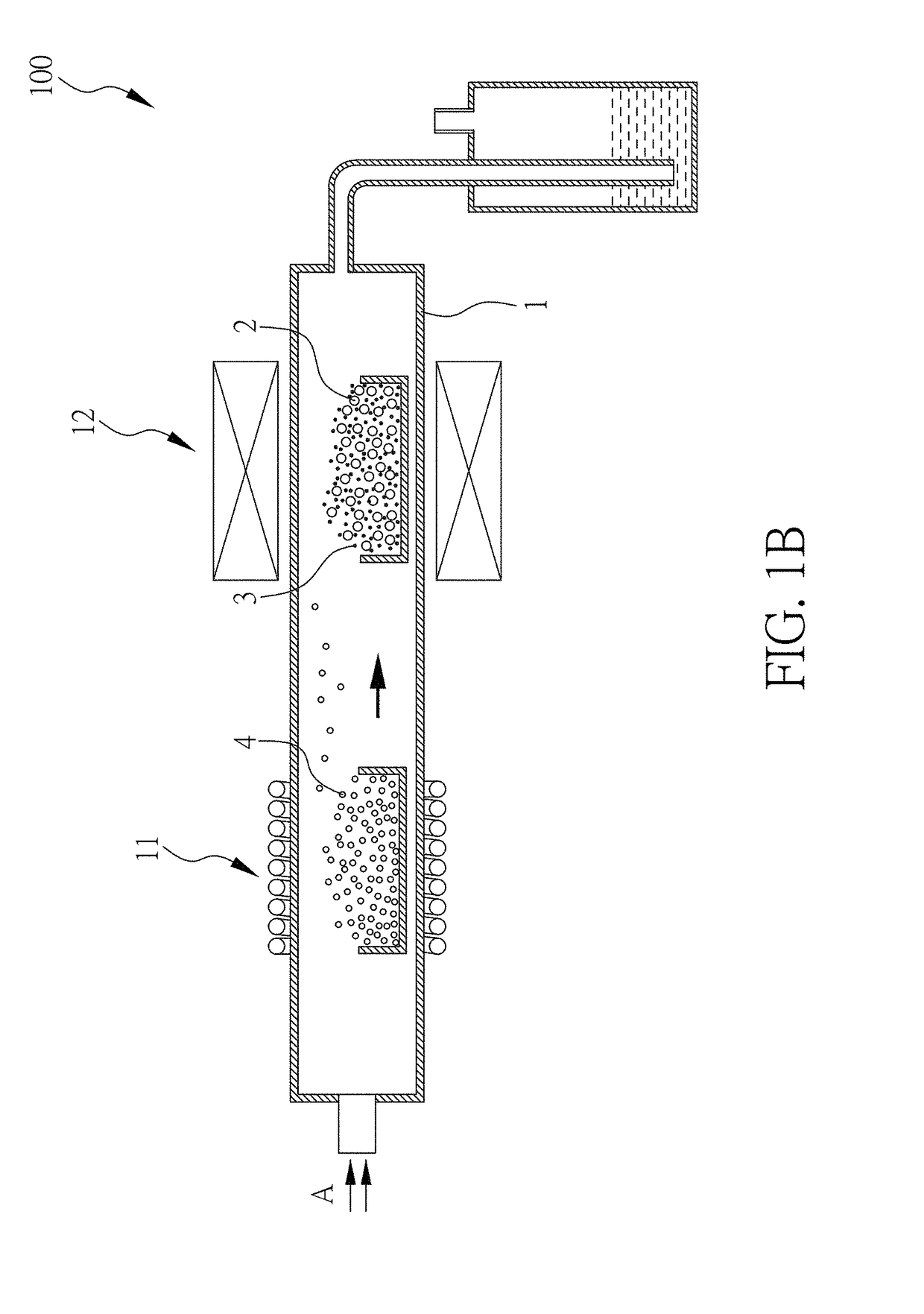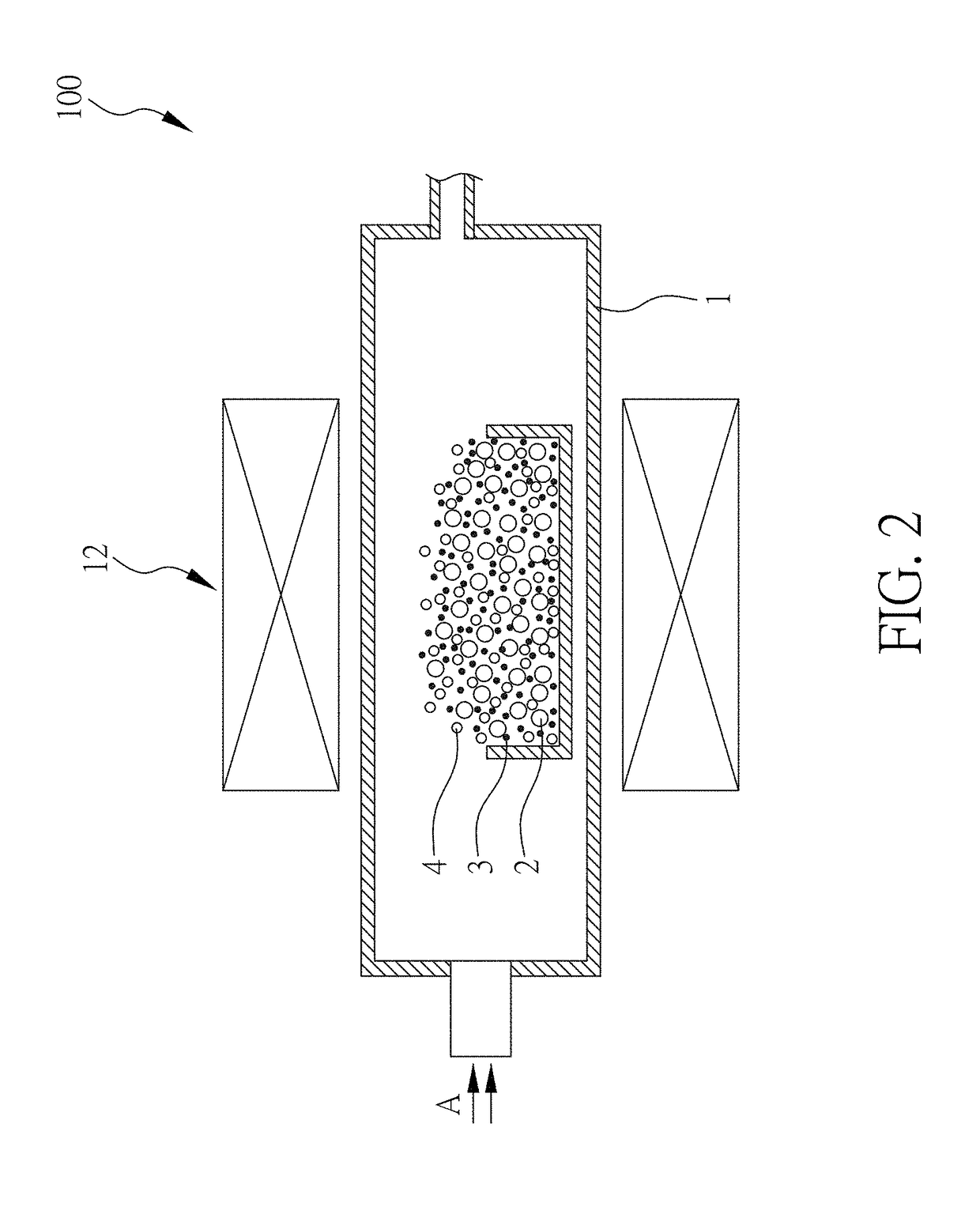Composite electrode material and method for manufacturing the same
a technology of composite electrodes and electrodes, which is applied in the direction of cell components, instruments, optical radiation measurement, etc., can solve the problems of simple graphite electrodes that cannot meet the needs of the public, cracking of graphite and capacity loss, and irreversible capacity loss, etc., to achieve excellent capacity, cycle life, and efficiency.
- Summary
- Abstract
- Description
- Claims
- Application Information
AI Technical Summary
Benefits of technology
Problems solved by technology
Method used
Image
Examples
preparation example 1
osite Electrode Material
[0034]FIGS. 1A and 1B show manufacturing schemes according to the present embodiment. Silicon powder 2 (1.86 g) having a thickness of 100 nm and an average length or width of about 850 nm was placed in a chamber 1 of a second zone 12 of a thermal chemical vapor deposition system 100. Also, ferrocene 3 (3 g) used as an iron source was placed in a first zone 11 of the chamber 1. Thereafter, the chamber 1 was evacuated to high vacuum and backfilled with argon gas (600 sccm, 4 minutes) in a direction of gas flow A to remain the chamber 1 at 1 atm. The argon gas (600 sccm) was remained to flow into the chamber 1 in the direction of gas flow A. At the same time, a high temperature furnace was turned on to ensure the first zone 11 was heated to about 160° C. and the second zone 12 was heated to about 850° C. to decompose and vaporize ferrocene 3. The vaporized iron particles could permeate into gaps between silicon powders, and the deposition time was about 15 minut...
preparation example 2
osite Electrode Material
[0035]FIG. 2 shows a manufacturing scheme according to the present embodiment. Silicon powder 2 (1.86 g) having a thickness of 100 nm and an average length or width of about 850 nm, ferrocene 3 (3 g), and camphor 4 (13 g) were placed in a chamber 1 of a thermal chemical vapor deposition system 100. After the air in the chamber 1 was diluted to remove the air inside and the chamber 1 was backfilled with argon or nitrogen in a direction of gas flow A to about 1 atm pressure, the gas inlet and outlet of the chamber 1 were closed. Thereafter, a high temperature furnace was turned on to heat the chamber 1 to about 850° C. so as to vaporize ferrocene 3 and camphor 4. Both of the vaporized ferrocene and camphor were retained in the chamber 1. Furthermore, carbon nanotubes and carbon fibers grew on the silicon powder at the presence of Fe-based catalyst (i.e. ferrocene), and the deposition time was about 30 minutes. Then the high temperature furnace was turned off, a...
preparation example 3
osite Electrode
[0038]A composite electrode material according to the present invention, a conductive carbon black and an adhesive agent sodium carboxymethyl cellulose (NaCMC) were mixed at a weight ratio of 6:3:1. Then the mixture was added with deionized water, and stirred with a DC mixer to obtain a homogeneous active material. The homogeneous active material was placed in a vacuum chamber which was evacuated to a low pressure to remove internal bubbles of the homogeneous active material. Thereafter, a copper foil (10 μm) was provided and coated with 30 μm thick of the active material using a scraper to obtain an electrode. The coated electrode was placed in a vacuum oven, evacuated to vacuum, and baked at 65° C. for 8-12 hours to remove extra solvent. After cooling, the roll-press machine rolled and pressed the baked electrode to raise a packaging density of the electrode. Finally, the electrode was cut into a desired size. In one aspect of the present invention, the active mater...
PUM
| Property | Measurement | Unit |
|---|---|---|
| thickness | aaaaa | aaaaa |
| width | aaaaa | aaaaa |
| volume change | aaaaa | aaaaa |
Abstract
Description
Claims
Application Information
 Login to View More
Login to View More - R&D
- Intellectual Property
- Life Sciences
- Materials
- Tech Scout
- Unparalleled Data Quality
- Higher Quality Content
- 60% Fewer Hallucinations
Browse by: Latest US Patents, China's latest patents, Technical Efficacy Thesaurus, Application Domain, Technology Topic, Popular Technical Reports.
© 2025 PatSnap. All rights reserved.Legal|Privacy policy|Modern Slavery Act Transparency Statement|Sitemap|About US| Contact US: help@patsnap.com



